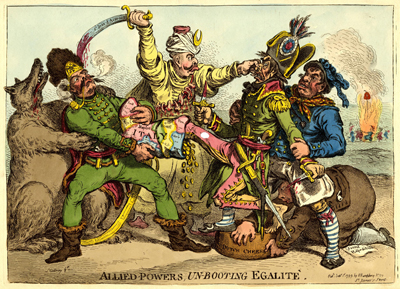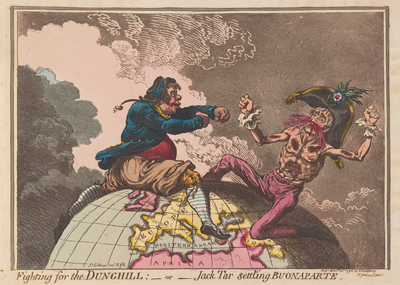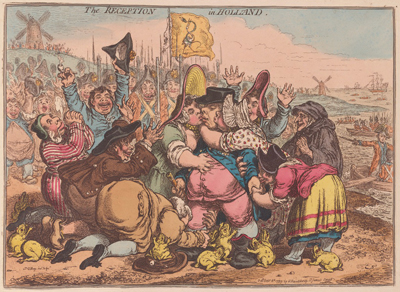Allied Powers, Un-Booting Egalitè
Using the older emblematic technique of national stereotypes, Gillray shows members of the Second Coalition reclaiming the possessions lost to France during Buonaparte's successful Italian campaign and removing the "boot" of Italy from French control. The "un-booting" is being celebrated in the background by a dance around a liberty tree (the first sign of French conquest) but this time as it goes up in flames.

© Trustees of the British Museum
The allied powers involved in that reversal of fortune were Russia, Austria, the Ottoman Empire, and England. Russia is represented by the symbolic Russian Bear; Austria, by a fierce looking Hussar with an Austrian double eagle on his grenadier's cap, the Ottoman Empire, by a blood-thirsty pasha looking to add to his collection of noses and ears acquired in battle; and Britain, by the the ever-reliable seaman Jack Tar with ribbons in his hat commemorating victories by Nelson, Duncan and Bridport. The British Museum commentary identifies Egalitè as Buonaparte, but if Gillray intended us to recognize the Frenchman as Buonaparte, why would he not have named him as such—Un-Booting Buonaparte?
In November 1798, in response to Nelson's Victory at the Battle of the Nile, Gillray had purposely changed the subtitle of his print Fighting for the Dunghill, from Jack Tar Settling Citoyen François to Jack Tar Settling Buonaparte.

[November 20, 1798]
© Beinecke Rare Book and Manuscript Library, Yale University
But in Allied Powers, Un-Booting Egalitè, Gillray clearly chose NOT to take that path, but to create a generic military man, Egalitè, to represent revolutionary France. And If we take a closer look at the two versions of the earlier Fighting for the Dunghill, I think we can explain why.
In the generic version of Fighting for the Dunghill, the wounds inflicted upon Citoyen François are labeled with the names of British Admirals such as Nelson, Warren, Bridport, and Duncan who all won victories over the French. In the Buonaparte version of the print, Gillray had to cover over most of the labeled bruises from his first version because those British victories did not involve Napoleon. Only Nelson was left because it was his victory over Buonaparte that was now being celebrated.
In Allied Powers, Un-Booting Egalitè, we have a similar situation. Nelson's victory over Buonaparte is alluded to in the ribbons of Jack Tar's cap, but so are Duncan's, and Bridport's which did not involve Napoleon. The victory by the combined English and Ottoman forces at St. Jean d'Acre (alluded to on the Pasha's scimitar), was against Buonaparte, but the victories by the forces of Austria and Russia at the Battle of Cassano and Marengo which freed Italy from French control were not won against Napoleon, but against the less capable French Generals, Moreau and Joubert. Gillray's use of the national stereotypes, hearkening back to techniques he used at the start of his career in prints like National Discourse (1780) and Dutchman in the Dumps (1781) is simply more accurate to describe a complex situation involving more than just Buonaparte.
There is one other figure in the print crawling between the legs of Jack Tar whose profile is distinctive enough to identify him. It is William V, Prince of Orange, Stadtholder of the Netherlands whose country had been taken over the French (not by Napoleon) in the Batavian Revolution of 1795. That identification is confirmed by the traditional Dutch clay pipe in his pocket and his firm grasp upon the round of "Dutch Cheese." Within a week of Un-Booting Egalitè Gillray produced The Reception in Holland which portrayed England's "secret expedition" to restore the Stadholder. But like most of the perceived gains by the Second Coaltion, it was illusory or temporary at best.The war with France continued with brief interruptions for another fifteen years. See my commentary on The Reception in Holland.

© Beinecke Rare Book and Manuscript Library, Yale University
Sources and Reading
- Commentary from the British Museum on Allied Powers, Un-Booting Egalitè.
- Draper Hill, Mr. Gillray The Caricaturist, 1965, p. 81n, 125
- Draper Hill, The Satirical Etchings of James Gillray, 1976, # 66.
- "War of the Second Coalition," Wikipedia
- "Italian and Swiss expedition," Wikipedia
- "Siege of Acre (1799)," Wikipedia
- "Russian Bear," Wikipedia
- "Jack Tar," Wikipedia
- Thomas Wright and R.H. Evans, Historical and Descriptive Account of the Caricatures of James Gillray #246.
- Thomas Wright and Joseph Grego, The Works of James Gillray, the Caricaturist; With the History of His Life and Times, p. 260.
Comments & Corrections
NOTE: Comments and/or corrections are always appreciated. To make that easier, I have included a form below that you can use. I promise never to share any of the info provided without your express permission.